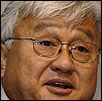Viral
Hepatitis: The Secret Epidemic
Hearing
by the Committee on Oversight and Government Reform, United States
House of Representatives, June 17, 2010
 |
|
Mike
Honda
|
In
response to the Institute of Medicine (IOM) report last January
-- Hepatitis and Liver Cancer: A National Strategy for Prevention
and Control of Hepatitis B and C -- and AASLD's collaboration
with the Trust for America's Health to bring attention to the
burden of liver disease created by viral hepatitis, the House
Oversight and Government Reform Committee held a hearing on
Thursday, June 17th entitled Viral Hepatitis: The Secret
Epidemic. During the hearing, the Committee urged Congress
to pass legislation to boost the diagnosis and treatment of
viral hepatitis. Witnesses included Representatives Hank Johnson,
Bill Cassidy and Mike Honda as well as Dr. Howard Koh, Assistant
Secretary for Health at the Department of Health and Human Services,
Mr. Randy Mayer, Chief of the Bureau of HIV, STD and Hepatitis
at the Iowa Department of Public Health, Mr. Michael Ninburg,
Executive Director of the Hepatitis Education Project, Dr. Jeffrey
Levi, TFAH, and Mr. Rolf Benirschke, Spokesperson for Hepatitis
C Awareness.
Representative Cassidy did an excellent job articulating the
impact of viral hepatitis should it go unchecked. He raised
the point that it costs $50 to vaccinate a child against HBV,
but costs over $1 million to treat a HBV patient over their
lifetime should they receive a liver transplant. He cited the
effectiveness of the vaccines for children program authorized
by Congress during the Clinton administration and urged Congress
to act again to fight viral hepatitis. He stressed that the
most important thing that can be done is to educate providers,
patients, and their families. In his testimony, Representative
Honda advocated for the support and passage of his bill, HR
3974.
Assistant Secretary Koh -- accompanied by Dr. John Ward -- said
that the interagency report would be completed this fall. He
cited the need for more research for a HCV vaccine, to improve
awareness of infection, reduce the spread of hepatitis in health
care settings, and raise awareness within and testing of high
risk populations. When asked by Chairman Towns (D-NY) whether
hepatitis could be eliminated, Koh responded that it could be
with the right resources. Koh also touched on screening guidelines
and cited the US Preventive Services Taskforce (USPSTF) as just
one of the groups that releases screening guidelines. Representative
Bilbray (R-CA) asked about the target population for screening,
saying he believes that the population should be viewed multi-dimensionally.
Koh and Ward responded that risk based screening models have
created barriers to screening and given the segment of the population
most likely to be developing symptoms, an age based strategy
could be more effective.
While both Democrats and Republicans on the committee agreed
that something must be done to prevent the spread of viral hepatitis,
the main obstacle remains funding for the needed programs.
|
|
|
|
 |
|
From
Paper to Practice:
Clinical Application of EASL
Guidelines for Optimal Management
|
|
|
|
|
|
|
 |
|
From
Paper to Practice:
Clinical Application of AASLD Guidelines
for Optimal Management
|
|
|
|
|
|
